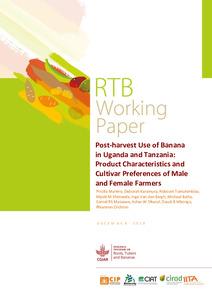Post-harvest use of banana in Uganda and Tanzania: Product characteristics and cultivar preferences of male and female farmers
Abstract
Understanding user preferred traits is important for the successful development and adoption of improved banana cultivars. This article provides an overview of different banana products, cultivars used to make those products and the preferred characteristics as reported by men and women farmers in different regions of Uganda and Tanzania. Qualitative data from 23 focus group discussions (FGDs) conducted in six districts (Mbarara and Luwero in Uganda; and Bukoba, Meru, Moshi and Rungwe in Tanzania) were coded and analysed. Results show that farmers process banana to make a range of products that include staple foods such as steamed matooke, mbalaga and machalari; alcoholic beverages and snacks. Different cultivars are preferred for an assortment of products. There are minimal differences in the cultivar preferences for specific products and product utilization patterns by men and women farmers. Differences only occurred when men and women described reasons why products are important or preferred, and in the roles of men, women and children in the preparation and processing of products from different banana types. Both men and women mentioned socio-economic, cultural, consumption and health-related attributes of the different products. However, women (73% of women only FGDs) specifically highlighted health benefits attached to women, for example after giving birth, during pregnancy, during lactation and for children; compared to 44% for men. Men pointed out more the socio-cultural importance of the products and provided detailed descriptions on market-related traits and the corresponding value chain actors (88.9% of men only FGDs). A myriad of factors that include variety of products, cultivar attributes before processing, characteristics of the processed product and location differences are identified, highlighting the need for further assessments and physicochemical characterisation of the traits to gauge the feasibility of considering this valuable information in the product development process. Some of the products and attributes of cultivars cited by farmers are generalized descriptions lacking sufficient detail (e.g. ‘tastes nice’, ‘good flavour’, ‘long shelf life’). Farmers have tacit knowledge of these attributes. Hence, researchers need to probe further and use a range of methods to extract this knowledge. There is a need for social scientists to collect data on trait prioritisation and for food scientists to do biochemical analyses to ensure information collected is well defined, comprehensive, quantifiable and measurable to effectively guide breeding and other agricultural research and development.

